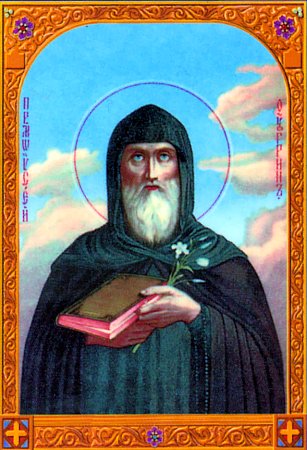Moses the Hungarian, of the Kiev Caves, venerable (Near Caves)
Dates of commemoration
(Church calendar - Feb 27) Synaxis of all Venerable Fathers of the Kiev Caves (movable feast on the 2nd Sunday of the Great Lent)
(Church calendar - May 7) Synaxis of all Venerable Fathers of Saint Panteleimon Monastery on Mount Athos
(Church calendar - May 15) Synaxis of All Saints of Carpathian Ruthenia (movable feast – 1st Sunday after May 11 – Ukr.)
(Church calendar - Jul 15) Synaxis of All Saints of Kiev
(Church calendar - Jul 26)
(Church calendar - Sep 28) Synaxis of the Saints of the Kievan Caves Monastery, venerated in the near caves of Venerable Anthony
Life
Saint Moses the Hungarian of the Caves, was a brother of Saint Ephraim of Novy Torg (January 28), and of Saint George. Together with them he entered into the service of the holy Prince Boris (July 24). After the murder of Saint Boris in 1015 at the River Alta (Saint George also perished with him), Saint Moses fled and hid himself at Kiev with Predislava, sister of prince Yaroslav. In 1018, when the Polish king Boleslav seized Kiev, Saint Moses and his companions wound up in Poland as captives.
Tall and handsome, Saint Moses attracted the attention of a certain rich Polish widow, who burned with a passionate desire for him and wanted to ransom him from captivity and make him her husband. Saint Moses resolutely refused to exchange captivity for slavery to a wife. Despite his refusal, the Polish woman bought the captive.
She did everything in her power to seduce the youth, but he preferred hunger pains to banquets of food. Then the Polish woman began to convey Saint Moses through her lands, thinking to captivate him by power and riches. Saint Moses told her that he would not trade spiritual riches for the perishable things of this world, and that he wished to become a monk.
Passing through the area, an Athonite hieromonk tonsured Saint Moses a monk. The Polish woman gave orders to stretch Saint Moses on the ground and to beat him with iron rods, so that the ground became soaked with his blood. She sought permission of Boleslav to do with the captive all that she pleased. The shameless woman once gave orders to put Saint Moses in a bed with her. She kissed and embraced him, but she accomplished nothing by this.
Saint Moses said, “From the fear of God I loathe you as impure”. Hearing this, the Polish woman gave orders to give the saint each day a hundred lashes, and then to emasculate him. Boleslav soon began a persecution against all the monks in the land, but sudden death overtook him. A revolt arose in Poland, in which the widow also was killed.
Having recovered from his wounds, Saint Moses arrived at the Kiev Caves monastery, bearing on himself martyr’s wounds and a crown of a confessor and courageous warrior of Christ. The Lord provided him strength in his sufferings. A certain monastic brother, oppressed by impure passion, went to Saint Moses and sought his help, saying, “I promise to keep until death everything you tell me to do.” Saint Moses said: “As long as you live, do not speak a word to any woman.” The brother promised to obey the advice of the monk. Saint Moses had in his hand a staff, without which he was not able to walk because of the wounds which he had received. With this staff Saint Moses struck the chest of the brother who had approached him, and immediately he was delivered from temptation.
Saint Moses pursued asceticism at Kiev for 10 years; he died in about the year 1043 and was buried in the Near Caves. After venerating the saint’s holy relics and fervent prayer to him, the monks were healed of fleshly temptations.
Source:
https://oca.org/saints/lives/2017/07/26/102095-venerable-moses-the-hungarian-of-the-kiev-near-caves
Holy relic type
unless specified otherwise below, "holy relic" means a fragment of a bone of the saint
1. Holy relic
2. Holy relic
3. Holy relic
Location of the holy relic in the Cathedral:
1. North kliros, reliquary #5
2. Relics cabinet in the Altar sacristy, board #2
3. South kliros, reliquary #14, gilded silver cross
Troparion
Тропарь преподобного Моисея Угрина
глас 3
Другаго тя Иосифа,/ великий чистоты и целомудрия рачителю,/ всечестне и равноангельне Моисее,/ священными песньми восхваляюще, грешнии,/ молимтися прилежно:/ моли Христа Бога,/ яко да исцелит вся наша страсти// и подаст велию милость.
Ин тропарь преподобного Моисея Угрина, Печерского, в Ближних пещерах
глас 3
Труды и подвиги со страстьми по чистоте твоей видя, святе,/ кто не удивится?/ Глад бо, темницу и раны приемля,/ не поработился еси сластем ляховицы,/ но, яко царь, страстьми обладаяй,/ ныне и тогда воспрославился еси от Всевидящаго человеческая сердца,/ от Негоже во искушениих всем пособствовати благодать прием,/ пособствуй и нам, твою память чтущим,/ Моисее преподобне
Kontakion
Кондак преподобного Моисея Угрина
глас 3
В Вышних единаго Бога ища,/ земная вся презрел еси,/ о телеси своем нерадив,/ на муки мужески себе вдал еси,/ глад, жажду, узы, в темнице затворяемь, доблественно претерпел еси,/ биения, крове излияние и удов отрезание,/ чистаго ради девства твоего,/ мужески понесл еси./ И ныне с девственными лики предстоя Пресвятей Троице,/ от всех искушений моли избавитися вопиющим ти:/ радуйся, Моисее, отче блаженнейший.






